HTRF® package insert Human IL8 - Cisbio Bioassays
HTRF® package insert Human IL8 - Cisbio Bioassays
HTRF® package insert Human IL8 - Cisbio Bioassays
You also want an ePaper? Increase the reach of your titles
YUMPU automatically turns print PDFs into web optimized ePapers that Google loves.
R&D, Administration and Europe Office<br />
<strong>Cisbio</strong> <strong>Bioassays</strong><br />
Phone: +33 (0)4 66 79 67 05<br />
Fax: +33 (0)4 66 79 19 20<br />
E-mail: bioassays@cisbio.com<br />
Japan Office<br />
Sceti Medical Labo K.K.<br />
Phone: +81 (0)3 5510 2932<br />
Fax: +81 (0)3 5510 0130<br />
E-mail: reagent@scetimedilabo.co.jp<br />
USA Office<br />
<strong>Cisbio</strong> US, Inc.<br />
Phone : 888 963 4567<br />
Fax : 781 687 1500<br />
E-mail : htrfinfo@cisbio.us<br />
www.htrf.com<br />
<strong>Human</strong> <strong>IL8</strong><br />
For in vitro research use only<br />
Storage temperature : 2-8°C<br />
HTRF ® <strong>package</strong> <strong>insert</strong><br />
Document reference : 62<strong>IL8</strong>PEB rev10 (July 2009)<br />
Packaging details :<br />
62<strong>IL8</strong>PEB<br />
384-well low volume plate (20 µL)<br />
1,000 tests<br />
1. Assay description and intended use<br />
This assay is intended to be used for the quantitative determination of IL-8 in<br />
buffered solution or cell–culture supernatants.<br />
Anti-cytokine antibodies are respectively labeled with europium Cryptate and XL665. With their binding to<br />
IL-8 molecules, the two antibodies come into close proximity, allowing FRET to occur between the europium<br />
Cryptate and the allophycocyanin. This FRET increases proportionally to IL-8 concentrations.<br />
2. Background<br />
Anti-h<strong>IL8</strong><br />
XL conjugate<br />
Anti-h<strong>IL8</strong><br />
cryptate conjugate<br />
<strong>Human</strong> <strong>IL8</strong><br />
Interleukin-8 (IL-8) belongs to the CXC family type of chemokines. It is a non-glycosylated protein of 8 kDa found in at least under four variants of 79, 77, 72, and 69 amino acids<br />
which differ in the length of their N-terminal. They all originate from the proteases digestion of a precursor of 99 residues (1, 2, 3, 4). IL-8 is found in solution either as a monomer<br />
or a dimer. The two disulphide bonds (Cys-7/Cys-34 ; Cys-9/Cys-50) keep the two amino-terminal regions together which is essential for the biological activity of the molecule .<br />
Exogeneous stimuli such as LPS, but also IL-1b, TNFa and TNFbinduce the secretion of IL-8 by several cell types including monocytes, endothelial and epithelial cells, dermal<br />
fibroblasts, keratinocytes, neutrophils, hepatocytes, synovial cells, astrocytes and T lymphocytes .<br />
IL-8 has two receptors CXCR1 and CXCR2, both members of the GPCR family. Receptor density ranges from 300/cell on T cells and goes up to 20000/cell on neutrophils.<br />
IL-8 is chemotactic for a broad range of immunocompetent cells. It enhances the metabolism of reactive oxygen species, the release of enzymes from granules, and increases the<br />
expression of adhesion molecules .<br />
IL-8 may be of clinical relevance in psoriasis, as elevated concentrations are observed in psoriatic scales. IL-8 is also a marker of several inflammatory processes and may participate<br />
in the pathogenesis of rheumatoid arthritis, since excessive amounts of this factor are found in synovial fluids. The activation of neutrophils may enhance the migration<br />
of cells into the capillaries of the joints .<br />
3. Protocol<br />
3.1. Supplied reagents and reconstitution<br />
Allow the reagents to come to room temperature for at least 30 minutes before reconstitution.<br />
Supplied reagents<br />
Reagent reconstitution<br />
(stock solutions)<br />
Working solutions<br />
Anti- IL-8 - Cryptate Conjugate** 1 vial lyophilized*<br />
Add 5 mL of reconstitution buffer to each vial. Mix<br />
gently.<br />
Anti- IL-8- XL665 Conjugate 1 vial lyophilized*<br />
<br />
IL-8 calibrator. Concentrated recombinant <strong>IL8</strong>. 2 vials lyophilized*<br />
<br />
See label indications for reconstitution volume. Mix<br />
gently after reconstitution.<br />
Reconstitution buffer<br />
Diluent<br />
1 vial of 13 mL<br />
1 vial of 20 mL<br />
* All reagents were lyophilized in 50 mM phosphate buffer, pH 7, containing protease free BSA and stabilizers.<br />
** The Cryptate conjugate concentration was optimized for a maximum assay sensitivity and to ensure an average counting of 40,000 cps at 620 nm (384-well low volume format),<br />
using the reference PHERAstar Plus reader (BMG LABTECH).<br />
Precaution : HTRF® reagent concentrations have been set for optimal assay performances. Note that any dilution or improper use of the XL665 and Cryptate-conjugates will<br />
impair the assay’s quality.
3.2. Reagent storage and stability<br />
All reagents should be stored at 2-8°C until reconstituted. Once reconstituted, Cryptate and XL conjugates are stable 7 days at 4°C. They can be refrozen (-80°C) and thawed once.<br />
<strong>IL8</strong> is not stable once reconstituted. Always use fresh made <strong>IL8</strong> solutions and discard unused reagent. Two vials of maximum calibrator are supplied with the kit. Extra vials can<br />
be ordered separately (réf 62<strong>IL8</strong>CDA).<br />
3.3. Calibration curve preparation<br />
Reconstitute the maximum calibrator according to the indications printed on the label and follow the dilution sequence shown in the following table to draw up the calibration<br />
curve. For greater relevance of results, dilution must be carried out with the medium used for samples preparation (i.e. culture medium, diluent or with freshly made PO4 50<br />
mM, BSA 0.2% pH7...)<br />
3.4. Sample preparation<br />
Calibrator<br />
Calibrator concentration<br />
in pg/mL<br />
Preparation<br />
Cal 7 2000 200 µL reconstituted calibrator + 800 µL diluent<br />
Cal 6 1000 500 µL Cal 7 + 500 µL diluent<br />
Cal 5 500 500 µL Cal 6 + 500 µL diluent<br />
Cal 4 200 400 µL Cal 5 + 600 µL diluent<br />
Cal 3 100 500 µL Cal 4 + 500 µL diluent<br />
Cal 2 50 500 µL Cal 3 + 500 µL diluent<br />
Cal 1 20 400 µL Cal 2 + 600 µL diluent<br />
If necessary, dilute all samples to be assayed with the diluent or the more appropriate buffer i.e. culture medium, buffered solution.<br />
3.5. Assay protocol for 384-well low volume plate (20 µL)<br />
Dispense the reagents in the following order :<br />
· 10 µL sample or calibrator*<br />
· 5 µL anti-<strong>IL8</strong>-XL conjugate<br />
· 5 µL anti-<strong>IL8</strong>-Cryptate conjugate<br />
* For negative control, replace the calibrator by 10 µL of diluent.<br />
· Cover the plate with a plate sealer and incubate at room temperature for 2 hours.<br />
· Remove the plate sealer and read on a compatible HTRF® reader (more information about compatible reader at htrf.com/readers).<br />
3.6. Data reduction and example of a calibration curve<br />
[IL-8]<br />
pg/mL initial<br />
0<br />
20<br />
50<br />
100<br />
200<br />
500<br />
1000<br />
2000<br />
A (665nm) B (620nm) Ratio (1) Mean Ratio (2) CV % (3) Delta F % (4)<br />
1318<br />
1358<br />
1394<br />
1738<br />
1578<br />
1503<br />
1706<br />
1729<br />
2220<br />
2190<br />
3878<br />
3629<br />
6041<br />
6119<br />
10366<br />
10173<br />
35567<br />
36031<br />
35221<br />
43727<br />
34603<br />
32964<br />
33509<br />
33070<br />
31276<br />
34228<br />
35271<br />
33782<br />
33998<br />
35515<br />
34631<br />
34162<br />
371<br />
377<br />
396<br />
397<br />
456<br />
456<br />
509<br />
523<br />
710<br />
640<br />
1099<br />
1074<br />
1777<br />
1723<br />
2993<br />
2978<br />
374 1.2<br />
397 0.3 6<br />
456 0.0 22<br />
516 1.9 38<br />
675 7.3 81<br />
1087 1.6 191<br />
1750 2.2 368<br />
2986 0.4 699<br />
1. Ratio =<br />
2. Mean Ratio =<br />
A 665nm<br />
B 620nm<br />
x 10 4<br />
ratios<br />
2<br />
Std deviation<br />
3. CV = x 100<br />
Mean ratio<br />
Calibrator or sample Ratio - Ratio neg<br />
4. Delta F =<br />
x 100<br />
Ratio neg<br />
% Delta F<br />
(Ratio neg = negative control)<br />
800<br />
700<br />
600<br />
500<br />
400<br />
300<br />
200<br />
100<br />
0<br />
0 500 1000 1500 2000 2500<br />
[<strong>IL8</strong>] pg/ml<br />
This data should not be substituted for that obtained in the laboratory<br />
Delta F obtained for samples can be reported on the calibration curve to deduce respective IL-8 concentration.<br />
3.7. Kit performances and specificity<br />
No cross reactions were observed with IL-1b, IL-2, IL-6, IL-10, IL-12, TNFa, IFNg tested at concentrations up to 100 ng/mL.<br />
The sensitivity threshold of the assay is 15 pg/mL IL-8.<br />
2
4. Cell-based assay protocol<br />
In this protocol, reagent reconstitution and distribution have been modified in order to allow the direct measurement of IL-8 on stimulated cells. This protocol is particularly<br />
well adapted to secondary screening.<br />
4.1. Reagent reconstitution<br />
Supplied reagents<br />
Anti- IL-8 - Cryptate conjugate<br />
Anti- IL-8- XL665 conjugate<br />
IL-8 calibrator<br />
Reconstitution buffer<br />
Reagent reconstitution<br />
(stock solutions)<br />
1 vial<br />
Lyophilized*<br />
1 vial<br />
Lyophilized*<br />
2 vials<br />
Lyophilized*<br />
1 vial<br />
of 13 mL<br />
<br />
<br />
<br />
<br />
Reagents preparation<br />
* All reagents were lyophilized in 50 mM phosphate buffer, pH 7, containing protease free BSA and stabilizers.<br />
4.2. Reagent storage and stability<br />
Refer to § 3.2.<br />
4.3. Calibration curve preparation<br />
Reconstitute the freeze-dried material with 2 mL of culture medium. Mix gently.<br />
Calculate the reconstitution volume by dividing the reconstitution volume<br />
indicated on the labels of the vials by 1.67 (i.e. if 500 µL is printed on the calibrator<br />
label, the reconstitution volume will be 299.4 µL). Mix gently.<br />
See calibration curve preperation below.<br />
Ready to use : in the cell-based assay, the reconstitution buffer is not used for<br />
conjugate reconstitution. It is added as KF buffer at the end of the incubation to<br />
allow HTRF® readout.<br />
Reconstitute the maximum calibrator as indicated above with culture medium. Follow the same dilution sequence as shown in the table in § 3.3., replacing the diluent by culture<br />
medium.<br />
4.4 Sample preparation<br />
Cell density optimization is a key step in the IL-8 cell-based assay. Typically, the level of IL-8 produced by cells must fall within the 30-1000 pg/mL range.<br />
Optimization consists of testing a broad range of cell concentrations (e.g. between 200 and 25,000 cells per well) in the presence or the absence of a direct activator of IL-8 production,<br />
e.g. LPS at 10 µg/mL.<br />
In practice, resuspend the cells in the culture medium supplemented with the activator(s) or inhibitor(s) so that the desired number of cells will be dispensed under 6 µL.<br />
4.5. Cell-based assay protocol for 384-well low volume plates (20 µL final)<br />
Dispense the reagents in the following order:<br />
• 6 µL standard or cell suspension*<br />
• 2 µL anti-IL-8 Cryptate<br />
• 2 µL anti-IL-8 XL665<br />
* For negative control, replace the first reagent by 6 µL of culture medium.<br />
• Incubate the plate for 18 to 24 hours at 37°C in a CO 2<br />
incubator with a fully humidified atmosphere.<br />
• Add 10 µL of reconstitution buffer to all wells.<br />
• Read on a compatible HTRF® reader (more information about compatible reader at htrf-assays.com/readers).<br />
4.6. Reagents storage<br />
Store all reagents at +4°C.<br />
Copyright © 2009 CIS bio international, France<br />
HTRF®, TRACE®, and the HTRF logo are trademarks belonging to CIS bio international.<br />
HTRF® products are manufactured under one or more of the following patents and foreign equivalent : EP 0 180 492 / US 4,927,923 / US 5,220,012 / US 5,432,101 – EP 0 321 353 / US 5,457,185 /<br />
US 5,534,622 / US 5,346,996 / US 5,162,508 – EP 0 539 477 / US 5,512,493 – EP 0 539 435 / US 5,627,074 – EP 0 569 496 / US 5,527,684.<br />
CIS bio international hereby grants to those buying HTRF® products from CIS bio international or its affiliates / distributors, a worldwide, non-exclusive, royalty-free, limited license to use HTRF® technology with said products<br />
for in-house life science research only. Signal amplification and correction using HTRF ® technology are covered by the following U.S. patents or patent applications and foreign equivalents :<br />
US 5,512,493 – US 5,527,684 – US 6,352,672.<br />
3



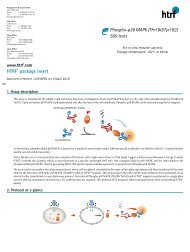

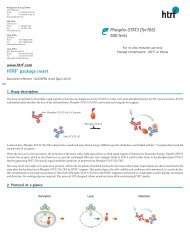
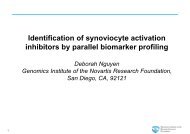
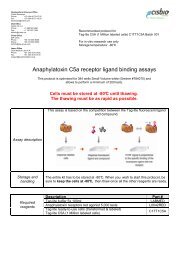
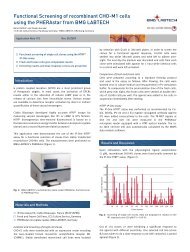
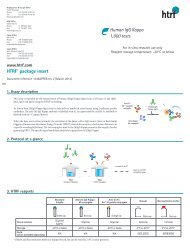
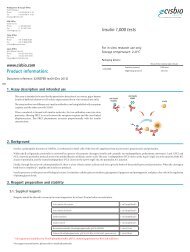

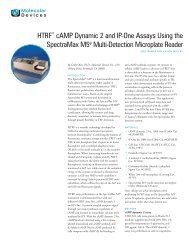

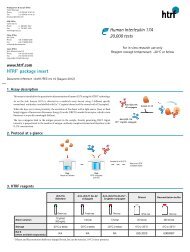
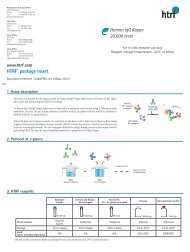
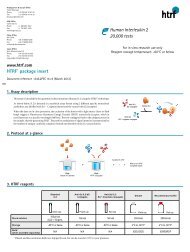
![HTRF meeting_130426_villa_pour pdf [Mode de compatibilité]](https://img.yumpu.com/22345646/1/190x135/htrf-meeting-130426-villa-pour-pdf-mode-de-compatibilitac.jpg?quality=85)